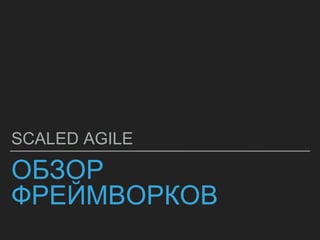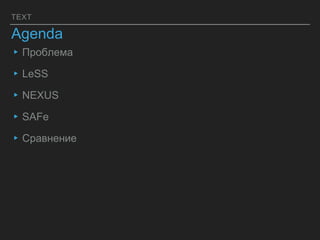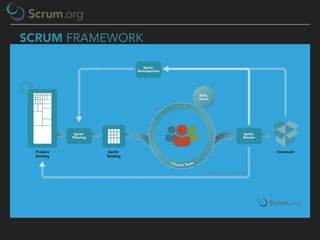–ě–Ī–∑–ĺ—Ä —Ą—Ä–Ķ–Ļ –ľ–≤–ĺ—Ä–ļ–ĺ–≤ –ľ–į—Ā—ą—ā–į–Ī–ł—Ä–ĺ–≤–į–Ĺ–ł—Ź Agile
- 3. TEXT Why? ‚Ėł–ĺ–≥—Ä–į–Ĺ–ł—á–Ķ–Ĺ–ł—Ź agile ‚Ėł–Ņ—Ä–ĺ—Ü–Ķ—Ā—Ā—č –≤–Ĺ—É—ā—Ä–ł –ļ–ĺ–ľ–Ņ–į–Ĺ–ł–ł
- 4. TEXT Scrum Limitation ‚Ėł–Ě–Ķ–Ī–ĺ–Ľ—Ć—ą–ĺ–Ļ —Ä–į–∑–ľ–Ķ—Ä –ļ–ĺ–ľ–į–Ĺ–ī ‚Ėł–ú–į–Ľ—č–Ļ —Ä–į–∑–ľ–Ķ—Ä –Ņ—Ä–ĺ–ī—É–ļ—ā–į ‚Ėł–†–į–Ī–ĺ—ā–į —Ā –ĺ–ī–Ĺ–ł–ľ –∑–į–ļ–į–∑—á–ł–ļ–ĺ–ľ (PO) ‚Ėł–ü–Ľ–į–Ĺ
- 7. Nexus Roles ‚Ä£ Nexus Integration Team ‚Ä£ PO ‚Ä£ SM ‚Ä£ NIT Team Member
- 8. Nexus Events ‚Ä£ Nexus Sprint Planning ‚Ä£ Nexus Daily Scrum ‚Ä£ Nexus Sprint Review ‚Ä£ Nexus Sprint Retrospectives ‚Ä£ Refinement
- 10. Sprint Planning
- 11. Coordination & Integration ‚ĖłJust Talk ‚ĖłCommunicate in Code ‚ĖłSend Observers to the Daily Scrum ‚ĖłScrum of Scrums ‚ĖłTravelers
- 12. TEXT LeSS: Sprint Review & Retrospectives
- 13. Product Backlog
- 14. TEXT HUGE
- 17. ¬ß Artefacts ‚ĖłSM, PO, DevTeam ‚ĖłRTE, PM, SysArchitect, BO SysTeam, DevOps
- 18. ¬ß Program Increment ‚ÄúThe most efficient and effective method of conveying information to and within a development team is face-to-face conversation.‚ÄĚ Agile Manifesto
- 19. § Program Increment Planning - IRL
- 20. § Program Board
- 21. § Program Board : IRL
- 22. § Executing
- 23. Similarities ‚Ä£ Team Set ‚Ä£ Two-level Events ( team + joint) ‚Ä£ Dependencies and Communication ‚Ä£ Focus on value
- 24. Differences ‚Ä£ Framework and ‚ÄúFramework‚ÄĚ ‚Ä£ Scrum on team level ‚Ä£ Events count ‚Ä£ FunctionalLine managers ‚Ä£ PO
Editor's Notes
- #4: —á—ā–ĺ —ā–į–ļ–ĺ–Ķ Agile? –ö—ā–ĺ —Ä–į–Ī–ĺ—ā–į–Ľ? –õ—é–ī\–≤–∑–į–ł–ľ–ĺ–ī–Ķ–Ļ—Ā—ā–≤–ł–Ķ –≤–į–∂–Ĺ–Ķ–Ķ –Ņ—Ä–ĺ—Ü–Ķ—Ā—Ā–ĺ–≤ –ł –ł–Ĺ—Ā—ā—Ä—É–ľ–Ķ–Ĺ—ā–ĺ–≤ –†–į–Ī.–Ņ—Ä–ĺ–ī—É–ļ—ā –≤–į–∂–Ĺ–Ķ–Ķ –ī–ĺ–ļ—É–ľ–Ķ–Ĺ—ā–į—Ü–ł–ł –°–ĺ—ā—Ä—É–ī. –∑–į–ļ–į–∑—á–ł–ļ–ĺ–ľ –≤–į–∂–Ĺ–Ķ–Ķ —É—Ā–Ľ–ĺ–≤–ł–Ļ –ļ–ĺ–Ĺ—ā—Ä–į–ļ—ā–į –ė–∑–ľ–Ķ–Ĺ–Ķ–Ĺ–ł—Ź –≤–į–∂–Ĺ–Ķ–Ķ —Ā–Ľ–Ķ–ī–ĺ–≤–į–Ĺ–ł—Ź –Ņ–Ķ—Ä–≤–ĺ–Ĺ–į—á–į–Ľ—Ć–Ĺ–ĺ–ľ—É –Ņ–Ľ–į–Ĺ—É 3-9 —á–Ķ–Ľ–ĺ–≤–Ķ–ļ (n*(n-1)) /2 ; 1-3-6-10-15-21-36-45
- #5: –≤ —á–ł—Ā—ā–ĺ–ľ –≤–ł–ī–Ķ –ļ–ĺ–ľ—É —á—ā–ĺ –Ĺ–Ķ –∑–Ĺ–į–ļ–ĺ–ľ–ĺ —Ā–Ņ—Ä–į—ą–ł–≤–į–Ļ—ā–Ķ
- #6: –ļ–Ķ–Ĺ —ą–≤–į–Ľ—Ć–Ī–Ķ—Ä + scrum.org. –ü—Ä–ĺ—Ā—ā–ĺ–Ķ –ł –Ľ–į–ļ–ĺ–Ĺ–ł—á–Ĺ–ĺ–Ķ scrum –ļ–į–ļ –Ī–į–∑–ĺ–≤—č–Ļ —ć–Ľ–Ķ–ľ–Ķ–Ĺ—ā. Nexus - –ļ–į–ļ —Ā—ā—Ä–ĺ–ł—ā–Ķ–Ľ—Ć–Ĺ—č–Ļ –Ī–Ľ–ĺ–ļ(–Ī–į–∑–ĺ–≤—č–Ļ —ć–Ľ–Ķ–ľ–Ķ–Ĺ—ā). –§—Ä–Ķ–Ļ–ľ–ĺ–≤—Ä–ļ —Ā–ĺ—Ā—ā–ĺ–ł—ā –ł–∑ —Ä–ĺ–Ľ–Ķ–Ļ —Ā–ĺ–Ī—č—ā–ł–Ļ –į—Ä—ā–Ķ—Ą–į–ļ—ā–ĺ–≤ –†–į–Ī–ĺ—ā–į –ī–ĺ–Ľ–∂–Ĺ–į –Ī—č—ā—Ć –ĺ—Ä–≥–į–Ĺ–ł–∑–ĺ–≤–į–Ĺ–į, –≤—č—Ā—ā—Ä–ĺ–Ķ–Ĺ–į –Ņ–ĺ –ĺ—á–Ķ—Ä–Ķ–ī–ł –ł –∑–į–≤–ł—Ā–ł–ľ–ĺ—Ā—ā–Ķ–Ļ –Ķ–ļ–∑–ĺ—Ā–ļ–Ķ–Ľ–Ķ—ā
- #7: –ĺ–ļ –ī–Ľ—Ź —ā–Ķ—Ö –ļ—ā–ĺ –∑–Ĺ–į–ļ–ĺ–ľ, –Ĺ–ĺ –≤–Ĺ–ł–ľ–į–Ĺ–ł–Ķ –∑–į–≤–ł—Ā–ł–ľ–ĺ—Ā—ā—Ź–ľ –ľ–Ķ–∂–ī—É –ļ–ĺ–ľ–į–Ĺ–ī–į–ľ–ł
- #8: –ö–ĺ–ľ–į–Ĺ–ī–į –ė–Ĺ—ā–Ķ–≥—Ä–į—Ü–ł–ł –Ě–Ķ–ļ—Ā—É—Ā–į –ĺ—ā–≤–Ķ—ā—Ā—ā–≤–Ķ–Ĺ–Ĺ–į –∑–į —ā–ĺ, —á—ā–ĺ–Ī—č –ė–Ĺ—ā–Ķ–≥—Ä–ł—Ä–ĺ–≤–į–Ĺ–Ĺ—č–Ļ –ė–Ĺ–ļ—Ä–Ķ–ľ–Ķ–Ĺ—ā –Ņ—Ä–ĺ–ł–∑–≤–ĺ–ī–ł–Ľ–į—Ā—Ć –ļ–į–ļ –ľ–ł–Ĺ–ł–ľ—É–ľ –ļ–į–∂–ī—č–Ļ –°–Ņ—Ä–ł–Ĺ—ā –ł –ļ–ĺ—ā–ĺ—Ä—č–Ķ –Ņ–ĺ—ā–Ķ–Ĺ—Ü–ł–į–Ľ—Ć–Ĺ–ĺ –ľ–ĺ–∂–Ĺ–ĺ –Ņ–ĺ—Ā—ā–į–≤–ł—ā—Ć –†–ĺ–Ľ–ł: - NIT –ļ–ĺ–ĺ—Ä–ī–ł–Ĺ–ł—Ä—É–Ķ—ā –ĺ–Ī—É—á–į–Ķ—ā –Ĺ–į–Ī–Ľ—é–ī–į–Ķ—ā - –í —Ā–Ľ—É—á–į–Ķ –ļ–ĺ–Ĺ—Ą–Ľ–ł–ļ—ā–ĺ–≤ NIT –Ī–ĺ–Ľ–Ķ–Ķ –Ņ—Ä–ł–ĺ—Ä–ł—ā–Ķ—ā–Ķ–Ĺ - —Ā–ĺ—Ā—ā–į–≤ –ľ–Ķ–Ĺ—Ź–Ķ—ā—Ā—Ź PO 1 Prod backlog = 1 PO (from Scrum) ordering Prod Backlog + maximum value SM –≥–į—Ä–į–Ĺ—ā–ł—Ä—É–Ķ—ā —á—ā–ĺ —Ą—Ä–Ķ–Ļ–ľ–≤–ĺ—Ä–ļ –Ņ–ĺ–Ĺ—Ź—ā –ł –ł—Ā–Ņ–ĺ–Ľ—Ć–∑—É–Ķ—ā—Ā—Ź –ļ–ĺ—É—á-—Ą–į—Ā–ł–Ľ–ł—ā–į—ā–ĺ—Ä + –ľ–ĺ–∂–Ķ—ā –Ī—č—ā—Ć –°–ú –≤ –ī—Ä—É–≥–ł—Ö –ļ–ĺ–ľ–į–Ĺ–ī–į—Ö, NIT members - —Ā–ł—Ā—ā–Ķ–ľ–Ĺ—č–Ķ –ł–Ĺ–∂–Ķ–Ĺ–Ķ—Ä—č –ł skilled-—É—á–į—Ā—ā–Ĺ–ł–ļ–ł –ļ–ĺ–ľ–į–Ĺ–ī –Ĺ–Ķ —ā–ĺ–Ľ—Ć–ļ–ĺ –≤—č—Ź–≤–Ľ—Ź–Ķ—ā –∑–į–ļ–ĺ–Ĺ–ĺ–ľ–Ķ—Ä–Ĺ–ĺ—Ā—ā–ł –ł –∑–į–≤–ł—Ā–ł–ľ–ĺ—Ā—ā–ł –Ĺ–ĺ –ĺ–Ī—É—á–į–Ķ—ā –ļ–ĺ–ľ–į–Ĺ–ī—č( —ā–į–ļ –ļ–į–ļ –ļ–į–Ļ–ī–∑–Ķ–Ĺ) –ĺ–Ī—É—á–Ķ–Ĺ–ł–Ķ –Ņ—Ä–į–ļ—ā–ł–ļ–į–ľ –ł –ł–Ĺ—Ā—ā—Ä—É–ľ–Ķ–Ĺ—ā–į–ľ –ź—Ä—ā–ł—Ą–į–ļ—ā—č: Product backlog -> nexus sprint backlog-> team sprint backlog –°–ĺ–Ī—č—ā–ł—Ź: –ī–ĺ–Ņ–ĺ–Ľ–Ĺ—Ź—é—ā –ł–Ľ–ł –∑–į–ľ–Ķ–Ĺ—Ź—é—ā —Ā–ĺ–Ī—č—ā–ł—Ź –≤ –ĺ–Ī—č—á–Ĺ–ĺ–ľ —Ā–ļ—Ä–į–ľ–Ķ
- #9: NSP –ö–ĺ–ĺ—Ä–ī–ł–Ĺ–į—Ü–ł—Ź –į–ļ—ā–ł–≤–Ĺ–ĺ—Ā—ā–Ķ–Ļ –ü—Ä–Ķ–ī—Ā—ā–į–≤–ł—ā–Ķ–Ľ—Ć + –Ņ–ĺ –∂–Ķ–Ľ–į–Ĺ–ł—é –ĺ—ā –ļ–į–∂–ī–ĺ–Ļ –ļ–ĺ–ľ–į–Ĺ–ī—č(–≤ –ł–ī–Ķ–į–Ľ–Ķ –≤—Ā–Ķ) Nexus Sprint Goal –ü–ĺ—ā–ĺ–ľ —Ā–≤–ĺ–ł –Ľ–ł—á–Ĺ—č–Ķ SprintPlanning –ú–ĺ–≥—É—ā –≤—č—Ź–≤–Ľ—Ź–Ļ—Ā—Ź –∑–į–≤–ł—Ā–ł–ľ–ĺ—Ā—ā–ł (–≤–ł–∑—É–į–Ľ–ł–∑–ł—Ä—É—é—ā—Ā—Ź) NDS —ā–Ķ–ļ—É—Č–Ķ–Ķ —Ā–ĺ—Ā—ā–ĺ—Ź–Ĺ–ł–Ķ –ł –Ĺ–ĺ–≤—č–Ķ –∑–į–≤–ł—Ā–ł–ľ–ĺ—Ā—ā–ł –≤–Ľ–ł—Ź–Ĺ–ł–Ķ –Ĺ–į –ĺ–Ī—Č–ł–Ļ –ł–Ĺ—Ā—ā—Ä—É–ľ–Ķ–Ĺ—ā –ļ–į–∂–ī–ĺ–Ļ –ļ–ĺ–ľ–į–Ĺ–ī–ĺ–Ļ NSR –ĺ–Ī—Ä–į—ā–Ĺ–į—Ź —Ā–≤—Ź–∑—Ć –Ņ–ĺ –ė–Ĺ—ā–Ķ–≥—Ä–ł—Ä–ĺ–≤–į–Ĺ–Ĺ–ĺ–ľ—É –ł–Ĺ–ļ—Ä–Ķ–ľ–Ķ–Ĺ—ā—É –∑–į–ľ–Ķ–Ĺ—Ź–Ķ—ā –ĺ—ā–ī–Ķ–Ľ—Ć–Ĺ—č–Ķ —Ä–Ķ–≤—Ć—é –ľ–ł—ā–ł–Ĺ–≥–ł —ā–į–ļ –ļ–į–ļ –Ĺ—É–∂–Ĺ–į –ĺ–Ī—Ä–į—ā–Ĺ–ĺ —Ā–≤—Ź–∑–ł –≤ —Ü–Ķ–Ľ–ĺ–ľ, –Ņ–ĺ —á–į—Ā—ā—Ź–ľ –Ĺ–Ķ –≤–ł–ī–Ĺ–ĺ NSRet –Ņ–ĺ—Ā—ā–ĺ—Ź–Ĺ–Ĺ–ĺ–Ķ —É–Ľ—É—á—ą–Ķ–Ĺ–ł–Ķ. –§–ĺ–ļ—É—Ā–ł—Ä–ĺ–≤–į–Ĺ–ł–Ķ –Ĺ–į –Ņ—Ä–ĺ–Ī–Ľ–Ķ–ľ–į—Ö –ĺ–Ī—Ā—É–∂–ī–Ķ–Ĺ–ł–Ķ –Ņ—Ä–ĺ–Ī–Ľ–Ķ–ľ –Ņ–ĺ–≤–Ľ–ł—Ź–≤—ą–ł—Ö –Ī–ĺ–Ľ–Ķ–Ķ —á–Ķ–ľ –Ĺ–į –ĺ–ī–Ĺ—É –ļ–ĺ–ľ–į–Ĺ–ī—É –Ľ–ĺ–ļ–į–Ľ—Ć–Ĺ—č–Ķ —Ä–Ķ—ā—Ä–ĺ—Ā–Ņ–Ķ–ļ—ā–ł–≤—č —ā—Ä–Ķ—ā—Ć—Ź —á–į—Ā—ā—Ć - –ĺ–Ī—Ā—É–∂–ī–Ķ–Ĺ–ł–Ķ —Ä–Ķ—ą–Ķ–Ĺ–ł—Ź –ł –ļ–į–ļ –Ķ–≥–ĺ –ĺ—ā—Ā–Ľ–Ķ–∂–ł–≤–į—ā—Ć Ref - –ľ–ł–Ĺ–ł–ľ–į–Ľ—Ć–Ĺ—č–Ļ –Ņ–ĺ –ļ–ĺ–Ľ–ł—á–Ķ—Ā—ā–≤—É –ł –Ī–Ķ–∑ –∑–į–≤–ł—Ā–ł–ľ–ĺ—Ā—ā–Ķ–Ļ(WBS?) –Ē–Ķ–ļ–ĺ–ľ–Ņ–ĺ–∑–ł—Ü–ł—Ź –ó–į–≤–ł—Ā–ł–ľ–ĺ—Ā—ā–ł
- #10: from standard one-team Scrum. deep organizational change to become agile. LeSS is a scaled up one-team Scrum: ‚ÄĘ one Product Owner + single Product Backlog; ‚ÄĘ one Definition of Done for all teams, ‚ÄĘ one Potentially Shippable Product Increment at the end of each Sprint, ‚ÄĘ many complete, cross-functional team ‚ÄĘ one Sprint. What‚Äôs Different in LeSS from one team? ‚ÄĘ Sprint Planning Part 1: Product Owner + it includes people from all teams. self-manage to decide their division of Product Backlog Items. ‚ÄĘ Sprint Planning Part 2: independently and usually in parallel by each Team ‚ÄĘ Daily Scrum: independently by each Team, Team A may observe Team B. ‚ÄĘ Product Backlog Refinement: single-team PBR, the same as in one team Scrum. + multi-team PBR, ‚ÄĘ Sprint Review: In addition to the one Product Owner, it includes people from all teams, and relevant customers/users and other stakeholders. For the phase of inspecting the product increment and new items, consider a ‚Äúbazaar‚ÄĚ or ‚Äúscience fair‚ÄĚ style: a large room with multiple areas, each staffed by team members, where the items developed by teams are shown and discussed. ‚ÄĘ Overall Retrospective: This is a new meeting not found in one-team Scrum, and its purpose is to explore improving the overall system, rather than focusing on one Team. The maximum duration is 45 minutes per week of Sprint. It includes the Product Owner, Scrum Masters, and rotating representatives from each Team.
- #11: Sprint Planning One focus on selection of ready items from those offered by the Product Owner Sprint Goal. Product Owner presents the highest priority which team on with feature ‚ÄĘ Discuss coordination between teams during the upcoming sprint. Sprint Planning Two same as in one-team Scrum focuses on creating a plan of work to get to ‚Äėdone‚Äô for each item. plan of action or tasks comprise the Sprint Backlog. separate meeting per team where each team creates the plan for getting the items to ‚Äėdone‚Äô during the Sprint.
- #12: Just Talk Any member of a self-managing team would be able and. Communicate in Code continuous integration checked in to the central Send Observers to the Daily Scrum not the Scrum Master‚ÄĒas a silent observe. Scrum of Scrums (2-3 in week) A Scrum of Scrums meeting is a Daily-Scrum-like: ‚ÄĘ What did my team do that is relevant to other teams? ‚ÄĘ What will my team do that is relevant? ‚ÄĘ What are my team‚Äôs obstacles that other teams should know about or can help with? Travelers to exploit and break bottlenecks and create skill Each Sprint they join a different team, coaching via pairing, workshops, and teaching sessions.
- #13: Sprint Review The Sprint Review is an inspect-adapt point customers and stakeholders examine what the teams built discuss changes and new ideas. direction of the product review product together with team Sprint Review Bazaar - Stakeholders visit areas of interest. Retrospective - individual Retrospectives. - same as a one-team Scrum retrospective. - brainstorm about larger obstacles that are impeding ‚ÄĒ‚ÄĒ- Overall Retrospective - new meeting in LeSS. - cross-team, organizational and systemic problems within the organization. - systemic and organizational issues ‚ÄĘ How well are the teams working together? Are the Communities of Practice working? ‚ÄĘ Are the teams learning together? Is the Product Owner doing well?
- #14: Initial Product Backlog Refinement Before you start your first Sprint, you need a Product Backlog with some ready items, and a Definition of Done. Product Backlog Refinement Ongoing Product Backlog Refinement (PBR) is needed within splitting big items, detailing items until ready, and estimating. Note! Refinement of items is not done separately by the Product Owner or a business analysis group‚ÄĒdoing that would increase the lean wastes of hand-off and information scatter. ‚ÄĘ Overall Product Backlog Refinement (shared amongst all teams) ‚ÄĘ Team-level Product Backlog Refinement ‚ÄĘ Multi-team Product Backlog Refinement
- #15: > 8 teams. One Product Backlog, one Definition of Done, one Potentially Shippable Product Increment, one (overall) Product Owner, one Sprint. All Teams in one Sprint with one delivery. What‚Äôs Different? Role changes: Area PO. Artifact changes: ‚ÄúRequirement areas‚ÄĚ in Product Backlog; Area Backlog.
- #16: –Ĺ–į–ł–Ī–ĺ–Ľ–Ķ–Ķ –Ņ—Ä–ĺ–ī—É–ľ–į–Ĺ–Ĺ—č–Ļ - —Ą—Ä–Ķ–Ļ–ľ–≤–ĺ—Ä–ļ —É—Ä–ĺ–≤–Ķ–Ĺ—Ć enterprise –ł—Ā–Ņ–ĺ–Ľ—Ć–∑—É–Ķ—ā—Ā—Ź –≤ IBM 3-x –ł 4x —É—Ä–ĺ–≤–Ĺ–Ķ–Ĺ–Ĺ—č–Ļ Team - stories from backlog, sprint, iteration cadence, scrum(kanban) Program - ART(virt-Team) Value Stream - –Ņ–ĺ–ī–ī–Ķ—Ä–∂–ļ–į –Ī–ĺ–Ľ—Ć—ą–ł—Ö –ł —Ā–Ľ–ĺ–∂–Ĺ—č—Ö —Ä–Ķ—ą–Ķ–Ĺ–ł–Ļ. Sync ART. Portfolio - set of VS( set of solutions). –°—ā—Ä–į—ā–Ķ–≥–ł—á–Ķ—Ā–ļ–ł–Ķ —Ü–Ķ–Ľ–ł. –Ī—é–ī–∂–Ķ—ā–ł—Ä–ĺ–≤–į–Ĺ–ł–Ķ. Foundation - —Ā–ĺ–Ķ–ī–ł–Ĺ—Ź–Ķ—ā –≤—Ā–Ķ –≤–ľ–Ķ—Ā—ā–Ķ: –Ī–Ķ—Ä–Ķ–∂–Ľ–ł–≤—č–Ļ –ł –≥–ł–Ī–ļ–ł–Ļ —Ā–ļ–Ľ–į–ī —É–ľ–į, —ā–į–ļ–ł–Ķ –∂–Ķ –Ľ–ł–ī–Ķ—Ä—č —Ā–Ņ–ĺ—Ā–ĺ–Ī–Ĺ—č–Ķ —ć—ā–ĺ –≤–Ĺ–Ķ–ī—Ä–ł—ā—Ć, –ü—Ä–ł–Ĺ—Ü–ł–Ņ—č, –ļ–ĺ–ľ—é–Ĺ–ł—ā–ł.
- #17: long-lived, self-organized team-of-Agile-team 50-125—á–Ķ–Ľ–ĺ–≤–Ķ–ļ -> plan, execute, commit –≤–ľ–Ķ—Ā—ā–Ķ ART: - –≤—č—Ā—ā—Ä–į–ł–≤–į–Ķ—ā –ļ–ĺ–ľ–į–Ĺ–ī—č —Ā–ĺ–≥–Ľ–į—Ā–Ĺ–ĺ –ĺ–Ī—Č–Ķ–Ļ –ľ–ł—Ā—Ā–ł–ł - –∑–Ĺ–į—á–ł–ľ—č–Ļ –ł –∑–į–≤–Ķ—Ä—ą–Ķ–Ĺ–Ĺ—č–Ļ –Ņ—Ä–ĺ–ī—É–ļ—ā –ļ–į–∂–ī—č–Ķ 2 –Ĺ–Ķ–ī–Ķ–Ľ–ł - –°–ł–Ĺ—Ö—Ä–ĺ–Ĺ–ł–∑–ł—Ä—É–Ķ—ā –ł—ā–Ķ—Ä–į—Ü–ł–ł –ļ–ĺ–ľ–į–Ĺ–ī - —Ā–ĺ–Ī–ł—Ä–į–Ķ—ā –ł—ā–Ķ—Ä–į—Ü–ł–ł –≤ –Ķ–ī–ł–Ĺ—č–Ļ Program Increment - —Ā–ĺ–≥–Ľ–į—Ā–ĺ–≤—č–≤–į–Ķ—ā —Ā –į—Ä—Ö–ł—ā–Ķ–ļ—ā—É—Ä–ĺ–Ļ –ł –ĺ–Ī—Č–ł–ľ UX –ī–ł–∑–į–Ļ–Ĺ–ĺ–ľ
- #18: Scrum master - —Ą–į—Ā–ł–Ľ–ł—ā–į—ā–ĺ—Ä - –ī–≤–ł–≥–į–Ķ—ā –į–ī–∂–į–Ļ–Ľ - –Ņ–ĺ—Ā–Ķ—Č–į–Ķ—ā SoS, impediment, Product Owner - –Ī—ć–ļ–Ľ–ĺ–≥ –ļ–ĺ–ľ–į–Ĺ–ī—č, –ļ–į–ļ –∑–į–ļ–į–∑—á–ł–ļ, - –Ņ—Ä–ł–ĺ—Ä–ł—ā–Ķ—ā—č, —Ā –ľ–Ķ–Ĺ–Ķ–ī–∂–ľ–Ķ–Ĺ —ā–ĺ–Ņ –Ņ–ĺ PI. DevTeam - Dev\—ā–Ķ—Ā—ā–Ķ—Ä—č –ł –ī—Ä—É–≥–ł–Ķ —Ā–Ņ–Ķ—Ü–ł–į–Ľ–ł—Ā—ā—č –Ĺ—É–∂–Ĺ—č –ī–Ľ—Ź —Ä–į–Ī–ĺ—ā—č - –°–ĺ–∑–ī–į–Ĺ–ł–Ķ –Ņ–ĺ–Ľ—Ć–∑–ĺ–≤–į—ā–Ķ–Ľ—Ć—Ā–ļ–ĺ–Ļ –ł—Ā—ā–ĺ—Ä–ł–ł - —Ä–į–∑—Ä–į–Ī–ĺ—ā–ļ–ł –ļ—Ä–ł—ā–Ķ—Ä–ł–Ķ–≤ –Ņ—Ä–ł–Ķ–ľ–ļ–ł(DoD) - —ā–Ķ—Ā—ā—č - –ī–Ķ–Ľ–ł–≤–Ķ—Ä–ł—ā –ł—Ā—ā–ĺ—Ä–ł–ł –£—Ä–ĺ–≤–Ķ–Ĺ—Ć ART RTE - chief Scrum Master for the train Product Management - –Ņ—Ä–ĺ–≥—Ä–į–ľ–Ĺ—č–Ļ –Ī–Ķ–ļ–Ľ–ĺ–≥ System Architect Engineer - –į—Ä—Ö–ł—ā–Ķ–ļ—ā—É—Ä–Ĺ–ĺ–Ķ –ł —ā–Ķ—Ö–Ĺ–ł—á–Ķ—Ā–ļ–ĺ–Ķ —Ä—É–ļ–ĺ–≤–ĺ–ī—Ā—ā–≤–ĺ Business Owner and Customer - –ļ–Ľ—é—á–ł–≤—č–≤—č–Ķ —Ā—ā–Ķ–ļ—Ö–ĺ–Ľ–ī–Ķ—Ä—č System Team + DevOps - –ł–Ĺ—Ą—Ä–į—Ā—ā—Ä—É–ļ—ā—É—Ä–į, –ł–Ĺ—ā–Ķ–≥—Ä–į—Ü–ł—Ź, —ā–Ķ—Ā—ā–ł—Ä–ĺ–≤–į–Ĺ–ł–Ķ ART, –į–≤—ā–ĺ–ľ–į—ā–ł–∑–ł—Ä—É—é—ā –Ņ—Ä–ĺ—Ü–Ķ—Ā—Ā—č –ł–Ĺ—ā–Ķ–≥—Ä–į—Ü–ł–ł.
- #19: —Ā—ā–į–Ĺ–ī–į—Ä—ā–ł–∑–ĺ–≤–į–Ĺ–Ĺ–į—Ź –į–≥–Ķ–Ĺ–ī–į –Ņ—Ä–ł—Ā—É—ā—Ā—ā–≤—É—é—ā –≤—Ā–Ķ –ļ—ā–ĺ –ľ–ĺ–∂–Ķ—ā –ī–Ķ–Ĺ—Ć-–ī–≤–į
- #21: —Ä–Ķ–∑—É–Ľ—Ć—ā–į—ā - –ļ–ĺ–ľ–ł—ā–Ķ–Ĺ—ā –Ĺ–į —Ā–Ľ–Ķ–ī—É—é—Č–ł–Ļ PI –Ę—Ä–Ķ–Ī—É–Ķ—ā –Ņ–ĺ–ī–≥–ĺ—ā–ĺ–≤–ļ–ł –ļ–ĺ–ĺ—Ä–ī–ł–Ĺ–į—Ü–ł–ł –ł –ļ–ĺ–ľ–ľ—É–Ĺ–ł–ļ–į—Ü–ł–ł. –Ē–Ķ–Ľ–į–Ķ—ā—Ā—Ź –ī–ĺ –Ņ–Ľ–į–Ĺ–ł—Ä–ĺ–≤–į–Ĺ–ł—Ź
- #23: RTE SoS - –∑–į–≤–ł—Ā–ł–ľ–ĺ—Ā—ā–ł –ł –Ņ—Ä–ĺ–≥—Ä–Ķ—Ā—Ā Product Managers and Product Owner Inspect-Adopt PI SysDemo measurements and metrics Problem-solving workshops
- #27: –Ņ–ĺ—Ā—ā–ĺ—Ź–Ĺ—Ā—ā–≤–ĺ –Ņ—Ä–ĺ—Ü–Ķ—Ā—Ā–ĺ–≤ –ł –Ņ—Ä–į–ļ—ā–ł–ļ –ě–Ī—Č–ł–Ļ –ł–Ĺ—Ā—ā—Ä—É–ľ–Ķ–Ĺ—ā —ā—Ä–Ķ–Ĺ–Ķ—Ä—č –ł –ļ–ĺ–Ĺ—Ā—É–Ľ—Ć—ā–į–Ĺ—ā—č –Ņ–ĺ–ī–ī–Ķ—Ä–∂–ļ–į —ā–ĺ–Ņ-–ľ–Ķ–Ĺ–Ķ–ī–∂–ľ–Ķ–Ĺ—ā–į –≤–Ĺ—É—ā—Ä–Ķ–Ĺ–Ĺ–ł–Ķ —Ā—ā—Ä–Ķ–ľ–Ľ–Ķ–Ĺ–ł–Ķ –ļ–ĺ–ľ–į–Ĺ–ī—č


























